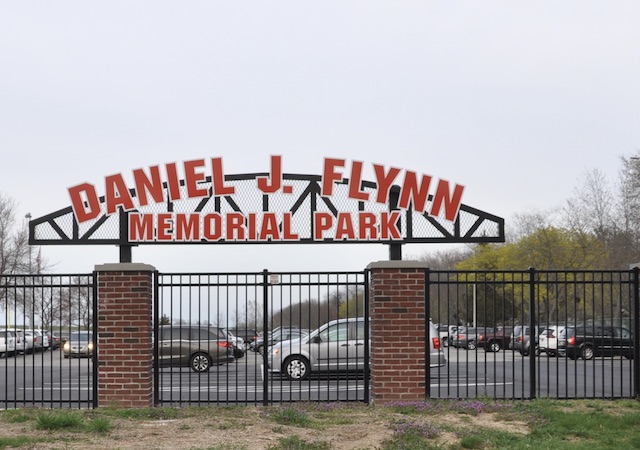“News of Long Ago” by Bradley Harris, Smithtown Historian
I have been writing about the history of the descendants of Judge J. Lawrence Smith and of the story of his daughter Bessie Smith who married Stanford White. Last week’s article was about the beginning of Stanford White’s affair with Evelyn Nesbit. This article deals with Stanford White’s murder in 1906.
“Stanford White’s murder….”
Stanford White was murdered on a balmy summer evening, June 25, 1906, as he sat at his reserved table near the stage of the open air Casino Theater atop Madison Square Garden. White was watching a new musical revue called “Mamzelle Champagne,” and as “the ladies of the chorus” danced their finale, a man named Harry Thaw crept “to within three feet of White’s table” where “he pulled out a revolver” he had been hiding “beneath his black overcoat,” leveled it at the back of Stanford White’s head, and began to squeeze the trigger. At the last second, White who must have “felt his presence,” turned toward Thaw “who aimed for the eyes, then fired three shots. Stanford White half rose, as if he were going to stand up, then pitched forward across his table, taking the edge of the tablecloth with him” as he fell to the floor scattering silverware and a wineglass. White was dead before he hit the floor. (Michael Macdonald Mooney, Evelyn Nesbit and Stanford White, William Morrow and Company, Inc., New York, 1976, pp. 224-225.)
“Thaw stood over his victim, holding the smoking revolver high in the air so all might see it, and then calmly emptied its chambers, the unexpended bullets falling beside the body of his victim.” The sound of the gunshots, the sight of the pistol, and the crash of Stanford White’s body hitting the floor brought a momentary silence in the theater followed by pandemonium as the panicked audience broke for the exits. “During the panic, Harry Thaw had not moved away from White’s body. Then with the revolver still in his hand, he walked to the elevator,” where he was quickly apprehended and placed under arrest. The only thing he muttered to those who corralled him was: “He deserved it. He deserved it and I can prove it.” There was never any question about Harry Thaw’s guilt, hundreds of people in the Casino Theater’s audience had seen him shoot Stanford White. The only question that begged to be answered was why he had done so. (Michael Macdonald Mooney, opt. cit., pp. 225-226.)
The morning editions of the newspapers all carried the story “supplying details of the murder – it was a sensation, pushing every other kind of news off the front pages.” Later editions of the papers carried “the standard obituaries of Stanford White, New York’s leading architect, and column after column listing his major works. There were background stories that featured White as a ‘leading clubman,’ a society leader, and an arbiter of taste. There were pages of pictures of White, of Harry K. Thaw” — the Pittsburgh millionaire who murdered White, and of Evelyn Nesbit, Harry’s wife. Evelyn was pictured in “an endless variety of poses, dug up from her career as Evelyn Nesbit, artist’s model.” And still later editions carried interviews with Harry Thaw, “from his cell at Tombs prison,” who readily explained “that he had shot White because the famous architect had ruined young girls.” What Harry didn’t say was that his wife Evelyn was one of those young girls who had been ruined by Stanford White. All of that would come out much later when Harry Thaw was tried for the murder of Stanford White. (Michael Macdonald Mooney, op. cit., pp. 231-232.)
Evelyn Nesbit began a lengthy affair with Stanford White following that fateful night in the fall of 1901 when White seduced her. He visited her again and again at her rooms in the Audubon Hotel, and they would meet “at his office or after the show” (Floradora) when they would go “to his twenty-fourth Street place or to his studio in the Tower above Madison Square Garden.” Evelyn would stay the night returning to her rooms at the Audubon early in the morning. “By Christmas of 1901 Mrs. Nesbit apparently trusted her sixteen-year-old daughter’s virtue to the forty-eight year experience of the fatherly Mr. White. Her mother no longer believed it necessary to meet Evelyn backstage after the show. Instead Evelyn would take a Union Club cab directly from Floradora to the Tower” or to the twenty-fourth street studio where she would join Stanford White. Apparently Mrs. Nesbit had no idea that one of White’s favorite gambits with Evelyn at the studio was to “put her in the red velvet swing stark naked and send her soaring toward the ceiling.” If she had known that, Mrs. Nesbit might have been less trusting of Mr. White’s fatherly interest in Evelyn. (Michael Macdonald Mooney, op. cit., pp.52-56.)
Many nights Stanford White would come to the Tower “from the opera or a theater opening” bringing friends with him and White “would serve supper for his celebrities with Evelyn at his side, and then when their guests had finally left, turn to his drawing board – still in his evening clothes – and begin to sketch. Evelyn loved to watch him working late at night on his designs.” Many nights, “Stanny would give her a ride in the elevator to its last stop, and then they would climb the spiral staircase to the top of Madison Square Garden’s Tower, three hundred feet above the streets of the city.” There on top of the Garden’s Tower, where White had installed a 13 foot statue of Diana, “sculpted in copper-bronze by his friend Augustus Saint-Gaudens, thirteen feet high and set on ball bearings to move as a weather vane,” Evelyn would “climb up” on the base of the statue and “holding tight to Diana’s heel,” she would “gaze out over the city.” According to Evelyn, the view of the city far below was “an enthralling sight” especially “on clear nights when the moon was full.” For Stanford White, that statue was a constant reminder of the time that he and Evelyn spent together. (Michael Macdonald Mooney, op. cit., pp.52-56.)
Throughout the winter and spring of 1902, Evelyn and Stanford spent many evenings together, but not on weekends, when Stanford spent time with his family on Long Island. “Sometimes he was away for a week or more because of his work, and when summer came around, he went off to Europe on one of his trips to buy things for his clients’ houses. He always took his wife with him.” Evelyn knew all this about Stanford since “she had asked about him backstage” at the Casino Theater and she knew he was married. “She knew he constantly worried about any scandal that might stigmatize his family and that although he lived ‘his other life’ in the city, he never neglected” his family. “He told her how much he respected his wife and how much he valued his son’s love, and she estimated that he must have been a marvelous and understanding father.” (Michael Macdonald Mooney, op. cit., pp.57-58.)
He also seemed to be an understanding lover. “There were times when Evelyn,” left alone in the city, “fretted about her inactivity.” She fretted so much that she went out with other men, admirers who had seen her perform in Floradora, or men she had met at one of Stanford’s parties. Young men who, according to Evelyn, were “more suited” to her age than “Stanford and his friends.” In this way, Evelyn met young John (Jack) Barrymore who was immediately smitten by her beauty and waited for an opportunity to be with her. In the summer of 1902, when Evelyn was starring in a new musical called The Wild Rose,” Stanford “went off to Canada on his annual summer salmon-fishing trip” leaving Evelyn on her own. Jack Barrymore made his move and every night he would call “for Evelyn at the stage door of The Wild Rose” and take her to supper at “Rector’s” where they “always had lots of fun.” In this way, a “passionate affair” between John Barrymore and Evelyn Nesbit began. (Michael Macdonald Mooney, op. cit., p. 58, p. 61.)
Stanford White didn’t seem to care and the affair went on into the fall until one night, the fun spilled over into Barrymore’s seedy apartment and Evelyn didn’t return to her hotel until the next morning where she discovered her “mother and Stanny were waiting for her.” Fearing that Evelyn was now pregnant, Mrs. Nesbit had Stanford take Evelyn to a doctor for an examination. Following the doctor’s visit, Stanford took Evelyn back to the Tower where “he explained to Evelyn that he felt he was responsible for her, that her mother was threatening to make a fuss because her mother thought she might be pregnant, and that he didn’t want any scandal. Evelyn said that if she was pregnant, she would be happy to marry Jack Barrymore.” But Stanford “explained in his kind fatherly way, that her mother had been adamant“ about not letting Evelyn marry Jack Barrymore because she felt the marriage would ruin her daughter’s career. Her mother’s insistence that she not marry Barrymore must have swayed Evelyn, because when Stanford White got Jack and Evelyn together in his Tower apartment to discuss the matter of Evelyn’s pregnancy, Jack asked Evelyn to marry him and Evelyn turned him down. It seemed that there was no way to avoid a scandal. And then Stanford White came up with a solution. (Michael Macdonald Mooney, op. cit., pp.62-63.)
Stanford returned Evelyn to her apartment in the Wellington and told Mrs. Nesbit that “he had arranged for Evelyn to be registered at a school in Pompton Lakes, New Jersey, which was quite secluded and very nice. He said he would drive her there the next day.” And so late in October, Evelyn was enrolled in “the DeMille School” in the Ramapo Hills, New Jersey, a small school for fifteen girls that was run by a Mrs. DeMille who ran her school “just like a home” where the girls actually studied “literature, and music and French.” (Michael Macdonald Mooney, op. cit., pp.64.)
Evelyn would stay for the duration of her pregnancy — out of sight, out of mind – until one morning, seven months later when Evelyn “was seized by a savage attack of abdominal pains.” Evelyn was taken to the school’s infirmary where local doctors attended to her. Evelyn’s mother was contacted. She immediately contacted Stanford White who contacted his private physicians who immediately travelled by train to reach the school. Evelyn’s mom arrived at the infirmary escorted by Harry Thaw who had offered to drive her there. Evelyn was prepped for surgery. (Michael Macdonald Mooney, op. cit., p.92.)
“The last thing Evelyn remembered before succumbing to the ether was her mother, Mrs. DeMille, white-robed doctors and nurses all standing around her bed, and Harry Thaw on his knees beside the operating table, kissing her clenched hands. Then blankness. If any child was born that day to an eighteen-year-old mother, no one seemed to remember it, and every doctor in attendance agreed that Evelyn Nesbit had probably had an attack of ‘acute appendicitis.’” One thing that Evelyn remembered when she regained consciousness the next day was the sight of “Stanny sitting at her bed side, saying, ‘Poor kiddie, poor little kiddie.’” After consulting with the doctors, Stanford White “arranged to have her moved from Mrs. DeMille’s to a private sanatorium” in New York City where she slowly recovered from her operation. Evelyn was able to receive visitors and Stanford White and Harry Thaw came to see her on a regular basis. Amazingly, they never seemed to arrive together and managed to stay out of each other’s presence. (Michael Macdonald Mooney, op. cit., pp.92-93.)
It was at this point in Evelyn’s life that 32 year old Harry K. Thaw managed to weasel his way into her life. He had tried to do that in January of 1902. Harry first attempted to impress Evelyn with his money and his devotion when she was appearing on the stage in Floradora. He sent her bouquets of flowers, gifts, and talked another girl into inviting Evelyn to tea at Reckler’s, and then joined the girls at their table as they were having tea. Evelyn remembered that “he appeared to be in his thirties,” that “he was tall, with coarse black hair combed almost straight back, and he was clean shaven. He had a short, wide nose, and Evelyn thought his eyes had a wild look – ‘he glared’ – she said. There was something about him that was frightening. He spoke in short, clipped sentences.” And when he told Evelyn “she was the prettiest girl in New York” and kept insisting on it, Evelyn excused herself and left the restaurant. (Michael Macdonald Mooney, op. cit., pp. 77-78.)
After that initial encounter, Evelyn wanted nothing more to do with Harry Thaw of Pittsburgh, the heir to forty million dollars in Pennsylvannia Railroad bonds. He certainly was an odd duck who had never really worked a day in his life, was tossed out of colleges he attended, and lived off the $80,000 yearly allowance his mother gave him. Harry was determined to see more of Evelyn and, when more flowers and invitations were refused, Harry attempted to call upon Evelyn and her mother at their hotel. But Evelyn still refused to see him. Apparently Harry never gave up, and he kept tabs on Evelyn and Stanford White. He must have been chagrined to discover that Evelyn was having an affair with John Barrymore, and he must have been even more disturbed to discover she was sent into seclusion in New Jersey. But “it seems that while Evelyn was at Mrs. DeMille’s School, Harry Thaw had made friends with Evelyn’s mother.” So much so that when Mrs. Nesbit needed to get to New Jersey to be there for her daughter’s operation, Harry was the person she relied on to get her there. Harry also made friends with Mrs. DeMille, sending her flowers and gifts, and he convinced her that he was “madly in love” with Evelyn and wanted to marry her. So it’s not surprising that Harry was in the operating room, on his knees, kissing Evelyn’s clenched hands. But it must have been quite a shock for Evelyn. (Michael Macdonald Mooney, op. cit., pp. 92-93.)
However in the weeks that followed Evelyn’s operation, while Evelyn was recuperating in the sanatorium in New York City, Harry Thaw visited her faithfully. Harry was very “careful of his behavior” making sure to be solicitous and kind, seeing that her every wish was granted, and paying to have a chef at the Waldorf Astoria standing by “day or night to satisfy Evelyn’s ‘wildest gastronomic whim.’” And when Evelyn was well enough to leave the sanatorium, Harry “suggested a sea voyage as a program of recuperation – a trip to Paris: no dancing, no theatrical work, no parties until she was strong again and then a grand tour of Europe.” Evelyn’s mother objected because she didn’t like Harry Thaw’s reputation, but Evelyn convinced her to come along on the trip to Europe. And so in May of 1903, Evelyn and her mother were aboard the S.S. New York, about to sail for Paris, when Sanford White showed up to see them off. “At the last moment Stanny gave Evelyn a letter of credit drawn on Cook’s for five hundred dollars – as a bon voyage gift or in case an emergency arose and she might need it.” It was a good thing he did that because Evelyn was about to set off on a European trip totally paid for by Harry Thaw’s money, a trip that would place her completely within Harry Thaw’s grasp. (Michael Macdonald Mooney, op. cit., pp. 93-94.)
 Wednesday, November 27, 2013 at 12:23PM
Wednesday, November 27, 2013 at 12:23PM 







